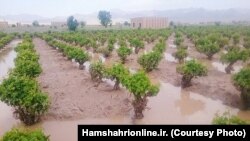An Iranian official says deadly floods that hit some of Iran’s provinces this week have caused heavy financial losses to the Islamic Republic’s agriculture sector.
A Friday report by Tehran-based state-approved newspaper Hamshahri quoted the head of the agriculture ministry’s crisis management department, Seyyed Mohammad Mousavi, as estimating flood losses at 24 trillion rials, or $180 million, based on the unofficial exchange rate of 135,000 rials to the dollar quoted by bonbast.com Friday.
The Iranian official said the losses were caused primarily in nine Iranian provinces, including Chaharmahal and Bakhtiari, Fars, Golestan, Kermanshah, North Khorasan, Khuzestan, Mazandaran, Semnan, and Sistan and Baluchestan.
Hamshahri cited Mousavi as saying 50 percent of the agricultural losses were related to farms, 23 percent to horticulture, 17 percent to water infrastructure and delivery networks, and 10 percent to livestock and fish.
Death toll at 44
In a Thursday report, Iran’s semi-official Tasnim news agency said floods had killed at least 44 people in 10 provinces since Monday.
In an interview with the Friday edition of VOA Persian’s News at Nine program, Washington-based climate and international security commentator Caitlin Werrell said Iran’s flooding damage was caused by a combination of two factors.
“One is the intensity of the weather event — we saw a huge amount of precipitation happen in a short period of time,” said Werrell, chief executive of The Council on Strategic Risks, a security policy institute.
“That was combined with the conditions on the ground: infrastructure and also … a drought that precedes a flood (and) means that the soil is not as absorbent as it could have been,” she added.
Updated infrastructure needed
Iranian officials acknowledged that outdated agricultural and irrigation systems and poor water management policies in the past decades contributed to nationwide water shortages last year. Below average precipitation exacerbated the situation.
Werrell also said there are steps that countries such as Iran can take to mitigate future flooding disasters, which she predicted will become more frequent as the climate changes.
“Short-term weather forecasting has gotten better, but you also can also put in place things like early warning systems for people who cannot get out of the way, things that I would encourage everybody, not just in Iran, but across the world to be doing,” she said.
This article originated in VOA’s Persian Service.











